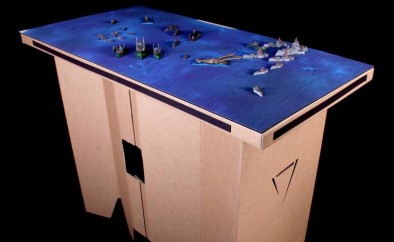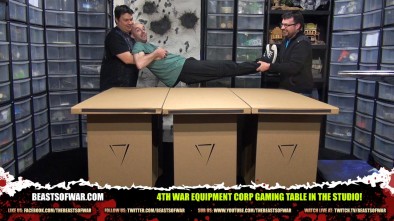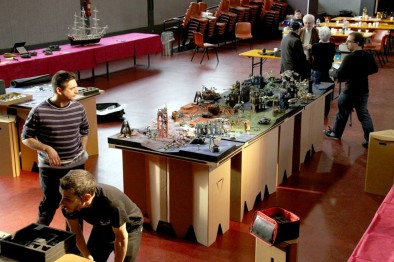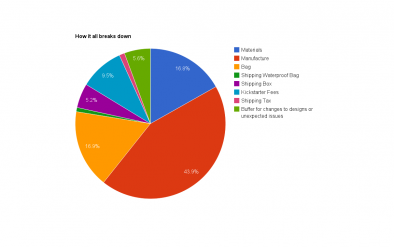Cardboard Gaming Table Costs and Science and S**t Yo!
April 30, 2014 by warzan
About a week ago we got a chance to try out the new modular cardboard gaming tables from 4th War.
While we liked the product and enjoyed leaving Justin (@dignity) lying stranded on it, the product itself and it’s resulting Kickstarter left us with a few questions.
So, we reached out to the guys at 4th War to try and learn more about the technical and financial details of the product, and see if we can uncover what makes a ‘cardboard product tick’.
Is it structurally sound...
Despite the fact we were able to lie Justin on the table, we wanted to know more about how the design of the table affected it’s stability and strength.
Cardboard is a bit of a wonder material, but one we tend to quickly dismiss as we see it practically every day. Its properties allow it to be folded and bonded in ways that would be very difficult (read expensive) to achieve with a plastic alternative.
The ‘engineering’ in cardboard design is to ensure that you play to the strengths and that means having the the corrugation align in the right directions to ensure load is always supported by the strongest elements.
Strength like a tree or a skyscraper…
There is a common misconception that strength is derived from rigidity, but in reality strength and stability are just as reliant on materials being able to bend or flex slightly. It is these properties that allow products to take a shock or a hit, and dissipate the energy rather than react directly to it. (The whole equal and opposite reaction stuff our old friend Newton described)
The 4th War gaming table has three specific areas that help here:
Pressure Positioning System - The legs have a blade structure that reacts to the amount of weight placed upon the table, in other words the more weight that is applied the resulting force exerts a pressure on to the leg assembly and more of the blades come into contact with the floor surface.
Seismic Attitude - There is a double skin on the surface of the table, this acts a kind of buffer to dissipate the energy from knocks and bumps and ensure that those types of vibrations are absorbed rather than ‘reflected’ or ‘amplified’, meaning your models are less likely to fall over.
Ferrite isotropic magnets - The magnets built into the edges of the tables are very strong, and don’t have a polarity. Typically these magnets are weaker than ‘Anisotropic Ferrite Magnets’ (those with a polarity) but the size of the magnets on the table more than compensates for that. The key here is that as you bind these tables together they become stronger.
We all like Beer right?
A concern we had was about the table and moisture, to be fair we’re not really concerned about dropping a drink or beer over the table, because we always try to take as much care over that as possible, and we’d be more worried about our terrain and miniatures than the table!
But we don’t all live in lovely climates like the designers over at 4th war (Sizzling Italy!) what about those of us (and I mean US!) that live in a rain forest without the forest.
Well the guys at 4th War really didn't have to do too much thinking about that, because the boffins who make cardboard have to deal with these things every single day, in every part of the world.
Quality cardboard's like those used in the 4th War table (high density cellulose), have a basic natural resistance to spills etc, and if you need to store it in a damp environment is comes packaged in a heavy duty plastic bag (Nearly un-tearable clear bag, not the carry bag!) to keep out the moisture. The guys even go so far as to say if you seal it with tape you could submerge it and it will be fine. (we don’t suggest that as an efficient way of storing your gaming table by the way)
They also have told us they will be looking into additional optional sealants and adhesive plastic coverings for the feet to ensure no moisture transfer.
So what about cost?
This was always going to be a key point for the product, because cardboard is cheap right? Well it’s not as clear cut as that. First lets look at the benefits its trying to achieve.
Light Weight
Folds into a very small space
Flexible and expandable
Safe to use on your floors and carpets (I have torn too many carpets with those fold away wallpaper tables!)
Now lets try to break down the production costs for a set of three tables costing $129 (spec ops pledge as referral point & + kickstarter exclusive bag)
Materials - $21.70
microtriple poliwave high performance cardboard, + magnets + velcro tape + special glue for cardboard
Manufacture - $56.60
Bag - $21.75
Shipping Waterproof Bag - $1.16
Shipping Box - $6.77
Kickstarter Fees - $12.26
Shipping Tax - $1.5
Buffer for changes to designs or unexpected issues - 7.26
Total: $129
As you can see if the figures they gave us are correct (and we've no reason to disbelieve them) they are running a fairly typical Kickstarter where budgets are down to the wire to try and get production up and running.
I’m sure they will find scope for cost breaks if they get to scale but from the figures above I would imagine that would become some well earned profit - or more likely go towards all the other costs a company faces these days.
So to Cardboard or Not to Cardboard?
For me there are clear benefits of a product like this, we have limited space and I would like our carpets to remain intact. We want to run small local events and having something both light and portable makes that possible.
All the little features they have took the time to develop, regarding stability etc, is all stuff we are unlikely to notice, but would surely miss them if they weren't there.
On top of it all, nothing is designed to last forever, and I do feel a little better knowing if and when it makes its way to the place for tables in the sky, it can be either recycled or bio degrade gracefully knowing it has hosted a multitude of epic battles for supremacy!
A big thanks goes out to 4th War for being so upfront about their product with us, and we wish them every success in trying to bring this to the market.
"There is a common misconception that strength is derived from rigidity"
Supported by (Turn Off)
Supported by (Turn Off)
"we don’t all live in lovely climates like the designers over at 4th war (Sizzling Italy!) what about those of us (and I mean US!) that live in a rain forest without the forest"
Supported by (Turn Off)















































































Believe it or not, these tables seem to have alot of scope for modifying to allow for longer life spans, vinyl wrapping the flat surfaces will increase strength and durability. I could even apply Kevlar strips to the folding points in the cardboard to increase longevity. Think I may hop on this kickstarter, any quibbles with wear and tear issues I could solve myself with minimum effort and cost and still have a very portable and easy to store product.
I’m with @deaddave on this one, I think I’ll be throwing some cash at this one myself.
I cant work out why they are so expensive tbh, especially with the postage, afterall, they don’t grow on trees you kno…….. oh wait…. 😛
Funny. 😀
best ever! funny!
Whoa! Pie charts and cost analysis! I’m logged on BoW at work to get AWAY from stuff like this! At least if my boss walks by now he’ll think I’m working. 🙂
We always aim to please 😉
I may well create a ‘THE BOSS IS COMING!!!’ Button that links to this page 😉
“Rain forest without the forest …” Epic. 🙂
you are a genius.
Mmmmm… Pie….
We are a backer, doing so when it first hit Kickstarter as we find this to be an interesting idea. As they have said the product will continue to see evolution as time goes on. It offers a flexible option for gaming.
Pretty impressive with the spilled water test. And for the knock test, he really beats the hell out of that table! I tell you what, if I was gaming and someone kicked, knocked,and bumped my table this much, they’d be in for a little “kick, knock, bumping” of their own!
At 1:48 … AWWW … he’s got a little kiddie-fort! Just like I had when I was 5. My Dad was in home improvement and he’d bring home big cardboard boxes of refrigerators, stoves, dishwashers, etc, and we’d build the most epic forts in the den for tennis ball wars! 🙂
Well thats most of my reservations about the product proved wrong 🙂 water, knocks etc.
now I just need to come up with a reason to by it…..thats a bit trickier.
I would like to see a test of them leaning on the edge as all wargamers do when considering their next move
challange accepted!! soon 4th war will make a video with this kind of test! continue to give us your feedback, make us demonstrate what YOU want to see, that’s what we want 4th war corp. do if we can make “her” live! thanks, really thanks for sharing your ideas!
torros have you seen the videos? what do you think about it?
I’ve been planning on building a table myself, so this popped up at the perfect time and I pulled the trigger on a pledge as soon as I saw it.
I definitely agree that cardboard gets overlooked, but if it’s the right stuff, it’s great – my experiences with a couple of KR cases has shown me that it’s not just for packaging Ikea furniture.
Shock distribution as well? Nice. No-one complains about crumple zones in cars, do they?
I like the idea and the only thing making me lean to the “NO” side is the $128 + cost of 3 mats + shipping is WAY to much for cardboard. I would be ok if the shipping wasn’t $55.
Did you see how bouncy it was when he pressed on it? Why would the extra legs ( blades ) only come into play when you put weight on it? Surely that means it’s dipping in the middle. I’d also like to see them lean on the edges like ‘everyone’ does while playing. When they’re in the bag they’re unweildly. Why would you ever choose these to take somewhere when they’re just as unweildly as a more secure, stronger and cheaper foldup alternative. And i’m still not buying the reasons for the prices. Don’t get me wrong, I like the… Read more »
The above seems like a fair breakdown and props to them them for entering into the discussion – However the issue for me is not the idea they are making mega bucks but for the product its at the wrong price point for me as a customer.
Ultimately a product is only work the value the customer attaches to it.
However good luck to them, and those that have back hope it funds for you
a normal cardbord table like this: http://move-itproducts.com/move-it-shop
will cost 68 dollar. we get here three ( in numbers: “3”) tables in a design made by tabletopers for tabletopers incl. a nylonbag and the shipping cost.
Thats not high-priced thats very cheap. we all forget that the tables are no Mass production like corrugated paper boxes for fruits and vegetables!!!
Well we’ve seen that it can hold a Justin, I’d be sold if it could take a Warren though 😛
An idea for Weekender guys? Also how did Justin manage to get off the table, and how long was he there for before he worked it out?
Decided to pledge for this project, as I’m definitely in need of a portable, storable table solution and this seems to fit the bill rather well. So far have pledged only for a single set of three tables, and I might add a Sport gaming mat and/or dice.
One thing I’m curious about is stretch goals, as there are simply none listed. Are there plans to add any kind of stretch goals if funding goes way over the initial $100K? Perhaps lower shipping charges or maybe one free mat of your choice… something like that.
It would be interesting to see whether some of the waterproofing sprays used for tents/hiking boots like Nikwax would work on this without distorting the table.
This looks like a great solution. I would like to share my humble opinion for anyone willing to read it. I see some people complain about the portability of it. Are you kidding me? I have regularly transported 3-2x4ft harboard tabletops and thats without legs and let me tell you, it’s a real pain.For this reason alone this is awesome…and a custom made carry bag? Could they make it any easier? Great detailing of the kick and bump and water tests. People are complaining that a few minis fell over. Big deal. Show me one portable/foldable tabletop that isn’t prone… Read more »
I did some research, as suggested, and it turns out I can buy two aluminum frame, resin top, 2’x6′ folding tables for less than $40 each at Sears, Wal-Mart, Lowe’s, Home Depot, etc. If I order them on the Internet and have them shipped to my local store, shipping charges are free. So for about $80 I can have a 4’x6′ gaming table that is more durable and just as easy to store and portage, sans nylon carry bag. It is an easy task to latch the tables together, and I have roughly $100 left over for accessories… or more… Read more »
But they is all evil conglomerates who have slave labour build their products in third world countries…
You’re right, you can indeed get a 6′ by 2′ folding table, steel frame, from Walmart for just under $40 ( http://www.walmart.com/ip/Mainstays-6-Centerfold-Table-Multiple-Colors/33148258#ProductDetail ) and two of them will make you a 6′ by 4′ gaming table. However, they do not have the shock resistance, the versatility of the 3x 4′ by 2′ boards (being able to make a 4×4 board for 1v1 Warhammer games is really useful), have a nifty carrying bag, and don’t magnetically connect together (which is just cool :P). Does the shipping hurt? Yes, yes it does, but not as bad as it could because they are… Read more »
I’m just not seeing $100 worth of advantage there. Free shipping from a place like walmart, the folding tables have handles, you can sit at them (the cardboard will be put to the test with all the kicking it will endure), and if you really need to secure them to each other you can get a couple clamps for less than lunch would cost you. I also don’t much buy into the versatility angle. A 4×4 table, even for a small game, isn’t enough room for cards, sheets, books, etc (I play plenty of board games on a drawing board… Read more »
Ah, one thing I want to point out about the price. If you get together with some friends and grab one of the Major packages ($339), then the price per table (9 tables) is $56 after shipping. That package also comes with 3 of the nylon bags. If you go for the Captain package ($299) that doesn’t have the nylon bags they work out to about $52 per table after adding shipping.
The price isn’t terrible (isn’t it like £80 ish for 3?) but even so It’s a big chunk of money. On the other hand… it will mean I can put all my raggedy cardboard boxes back in the garage and have a nice flat, even surface for once…
The only price point I can see that is worth complaing about is the Kickstarter fee 10% is a high margin Amazon is charging … but else I am in for one.
I have a couple of points to get off my chest. First up, your KS video. Brushing past the quick bid for sympathy pledges with the baby and wife I was amused and slightly offended by the immediate exit stage left of them and replacing them with the ranom big breasted booth babe. Also, for future videos, next time you hire a booth babe to present a video you plan on being in English, it might be a good idea to put ‘Can speak English fluently’ a few slots above ‘will show off boobs in low cut top’ on the… Read more »
and now unlocked also “only mat” pledge!
https://www.kickstarter.com/projects/4thwar/4thwar-equipment-wargaming-tables-returns